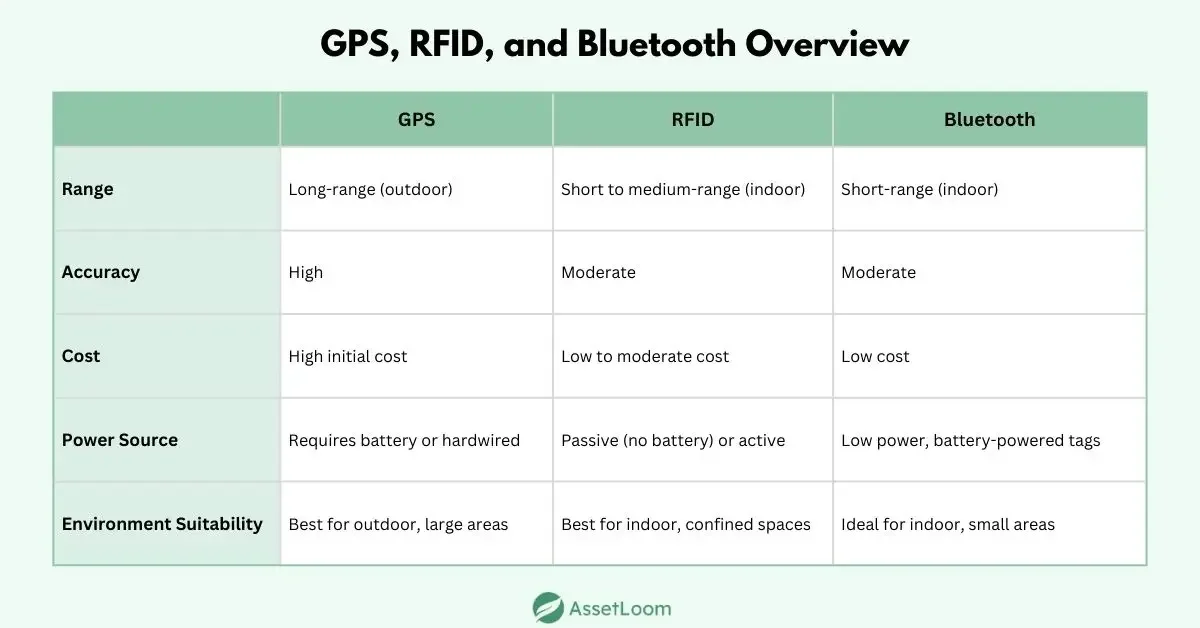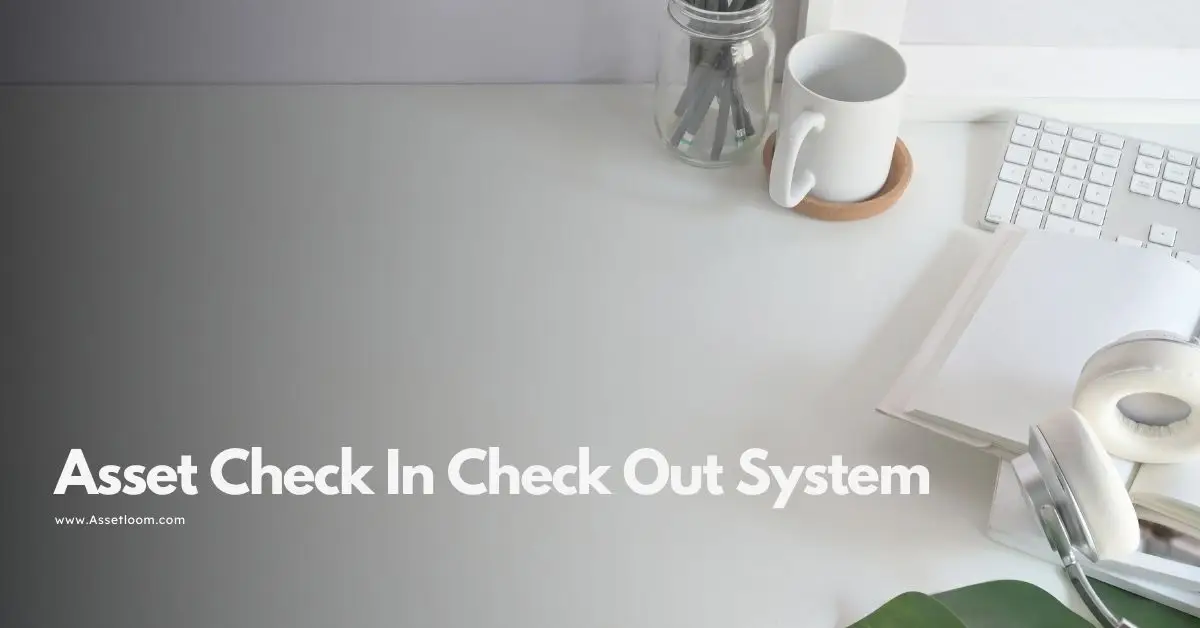Asset Location Tracking: GPS, RFID, or Bluetooth
GPS, RFID, and Bluetooth technologies are transforming asset location tracking in many ways. But which one is a perfect match to your needs?
When you think of tracking assets, what's the first thing that comes to mind?
I guess it’s GPS. Without a doubt, GPS is the perfect choice to track asset location, especially for assets like trucks, fleets, etc. But, it’s not the only option when it comes to asset location tracking. In fact, there are plenty of situations where GPS just doesn’t cut it, and businesses are turning to RFID and Bluetooth to solve their tracking problems in ways you might not expect.
It’s time to rethink the idea that GPS is king of asset tracking. Each technology, whether it’s GPS, RFID, or Bluetooth, brings its own strengths and weaknesses to the table. Let’s break down how asset location tracking works with each of these technologies, where they excel, and why one might be better suited than the others.
Asset Location Tracking Overview
Let’s get the basics out of the way: asset location tracking is exactly what it sounds like: keeping tabs on where your physical assets are at any given moment. Whether it’s your fleet of delivery trucks, high-value medical equipment, or inventory on the shelves, knowing where your stuff is located can save you a lot of time, money, and headaches.
But here’s the thing: the right asset location tracking system isn’t just about keeping track of things. It’s about using the right technology to make it all work efficiently. That’s where things get interesting. GPS, RFID, and Bluetooth are all game-changers, but they each bring something different to the table. The trick is figuring out which one works best for your specific situation.
_Learn more: Top 5 Best Asset Tracking Solution in 2025
GPS Technology
Okay, let’s start with GPS (Global Positioning System). Most people think of GPS when they picture asset tracking. After all, it’s been used for decades to track vehicles, ships, and pretty much anything that moves outdoors. And sure, GPS is great when you need to track something across a vast distance, like a delivery truck driving across the country. But here’s the problem: GPS isn’t all it’s cracked up to be.
Why GPS Isn’t Always the Best Option:
- It’s expensive. For one, GPS trackers can be pricey. You’re paying for satellite connections, data usage, and the tracking hardware itself. For large fleets or businesses with hundreds of assets, the cost adds up quickly.
- It can’t handle indoor tracking. GPS works great for outdoor use, but try using it to track something inside a warehouse or office building, and you’re out of luck. GPS signals get blocked by walls, and the accuracy takes a nosedive.
Real-life Example: A logistics company might rely on GPS to track its fleet of trucks, ensuring deliveries stay on time. But for the same company, tracking equipment within a warehouse with GPS? Not so effective.
Where GPS Wins:
- Long-range outdoor tracking (vehicles, shipments, moving assets)
- Real-time updates for large-scale logistics
- Ideal for high-value outdoor assets (construction equipment, cargo)
RFID Technology in Asset Location Tracking
Now, let’s talk about RFID. Most people think RFID is just a buzzword thrown around in warehouses and retail stores, but it’s a powerful tool for asset location tracking that often gets overshadowed by GPS.
Here’s the thing about RFID: it’s perfect for tracking assets in confined spaces or when GPS just isn’t going to cut it.
Why RFID is Underrated:
- RFID tags don’t need batteries (at least not all the time). Passive RFID tags are powered by the reader’s signal, making them more cost-effective and long-lasting.
- It’s great for indoor use. Whether you’re tracking assets in a warehouse or hospital, RFID works where GPS fails - inside buildings and tight spaces.
- It’s scalable. You can slap an RFID tag on practically any asset, and it’s easy to implement across a large facility.
Real-life Example: A warehouse uses RFID tags on pallets of goods. RFID readers placed throughout the warehouse keep track of when assets are moved, ensuring accurate inventory management. No GPS signal needed.
![]()
_Learn more: Traditional Asset Tags for Equipment Tracking vs. RFID: Which Is Better?
Where RFID Wins:
- Indoor tracking (warehouses, office buildings)
- High-volume asset management (inventory, medical equipment)
- Cost-effective compared to GPS for small assets
Bluetooth Technology in Asset Location Tracking
You might think of Bluetooth as just a way to connect your phone to a speaker or a set of headphones. Turns out, this technology has long been known since 1994. Originally designed as a way to wirelessly connect devices over short distances, Bluetooth is now used as a technology for asset location tracking. Most significantly, it works in environments where low-cost, low-power solutions are needed.
Why Bluetooth Might Just Be the Best Option:
- Low energy consumption. Bluetooth tags are small and battery-powered, but they last a long time. Plus, because BLE uses very little power, you can track assets without worrying about battery drain.
- It’s easy to set up. Bluetooth beacons can be installed with minimal effort, and you don’t need expensive infrastructure.
- Accuracy in confined spaces. Bluetooth tags can be placed on assets and tracked using beacons that estimate proximity based on signal strength. It’s the perfect solution for indoor tracking.
Real-life Example: A hospital tracks its medical equipment using Bluetooth tags. Beacons placed around the facility detect when equipment is moved between rooms, reducing time spent searching for devices.
Where Bluetooth Wins:
- Small-scale, indoor tracking (offices, hospitals, retail)
- Low-cost, low-power solution for asset management
- Quick to implement and scale for specific areas
GPS, RFID, or Bluetooth?
Alright, so we’ve seen the strengths and weaknesses of each technology, but how do they stack up against each other? Let’s break it down:

The Future of Asset Location Tracking Technologies
Let’s face it: we’re on the verge of seeing a whole new wave of tracking technology with 5G, AI, and IoT. These innovations will bring better coverage, faster data processing, and smarter tracking solutions. The truth is, no one technology will reign supreme. The future will be about integration, combining GPS, RFID, Bluetooth, and other technologies to create the perfect IT asset tracking software for your business.
When GPS, RFID, and Bluetooth Aren’t Enough
Let’s be honest. Sometimes, none of these technologies is a perfect fit for your business. Maybe your assets move between indoor and outdoor spaces, or you have hundreds of small items that are too costly to tag individually. Or perhaps you just want one central system to track everything without juggling multiple technologies.
This is where an IT asset tracking tool like AssetLoom comes in. Tools like AssetLoom help you:
- **Track all your assets in one place: **hardware, software, accessories, and more.
- Get real-time updates on location, usage, and status.
- Set alerts and notifications for maintenance, warranty expirations, or unusual movements.
- Simplify reporting and audits without the hassle of managing multiple tracking systems.
Even if GPS, RFID, or Bluetooth are part of your setup, having a centralized tool ensures nothing slips through the cracks. AssetLoom isn’t just a tracker, it’s your all-in-one solution for smarter, safer, and more efficient IT asset management.
Conclusion
GPS, RFID, and Bluetooth all have their place in asset location tracking, but none of them is a one-size-fits-all solution. Depending on your business needs, you need to choose the right technology for the job. But at least from now on, if someone tells you that GPS is the only way to track assets, don’t take their word for it. Explore the possibilities of RFID and Bluetooth, and you might just find a better, more cost-effective solution.

Subscribe for Expert Tips and Updates
Receive the latest news from AssetLoom. right in your inbox

